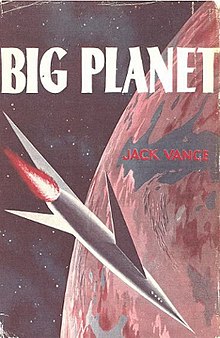Big Planet
 first edition (abridged) of the Big Planet | |
| Author | Jack Vance |
|---|---|
| Country | United States |
| Language | English |
| Genre | Science fiction novel |
| Publisher | Avalon Books |
Publication date | 1957 |
| Media type | Print (Hardback) |
| Followed by | Showboat World |
Big Planet is the first of two stand-alone science fiction novels by Jack Vance (the other being Showboat World) which share the same setting: an immense, but metal-poor and backward world called Big Planet.
Big Planet was first published in Startling Stories (vol. 27 no. 2, September 1952), then cut and reissued in 1957 by Avalon Books. It was later issued as part of Ace double novel D-295, paired with Vance's Slaves of the Klau. It was further cut in 1958. The text was restored in 1978.
Plot summary
Big Planet had been colonized hundreds of years prior to the start of the novel by misfits, faddists, cultists and anti-government advocates from Earth. It devolved into a large number of technologically backward societies, many of them ruled by petty tyrants and prey to internecine warfare. The environment is Earthlike, including the surface gravity: even though the planet is much larger than Earth (hence the name), its internal composition is much less dense.
Investigators from Earth, headed by protagonist Claude Glystra, arrive to start putting things right – to stop the importation of arms and halt Big Planet's slave trade – only to have their starship sabotaged. It crashes near a quaint village called Jubilith, and Glystra, one of the survivors, awakens to the jewel-bright morning light of a flowery mountain slope—with a view "vast beyond Earthly conception." Unfortunately, Jubilith is near the territory of Charley Lysidder, the Bajarnum of Beaujolais, one of the worst and most ambitious of tyrants. The survivors attempt to reach the only safe spot on Big Planet, Earth Enclave, forty thousand miles away. Already at odds with each other, the dwindling team begins to revert to the social level of the rest of Big Planet as Lysidder tries to pick them off.
Among the many societies benign or bizarre that Glystra and his companions encounter along the wind-driven monoline (their version of the yellow brick road), is the quasi-utopian society of Kirstendale. At first, it appears to be based on snobbish principles, but an odd twist reveals it to be surprisingly egalitarian.

Literary significance and criticism
According to science fiction scholar Nick Gevers, Big Planet
was instrumental in the development of the planetary romance form...perhaps the first attempt at a convincingly complete imaginary world in genre s-f....[T]he conviction persists that it is not the characters who serve as the book's protagonists, but rather Big Planet itself.[1]
References
- Underwood, Tim; Chuck Miller (1980). Jack Vance. New York: Taplinger Publishing Company. p. 227. ISBN 0-8008-4295-2.
External links
- List of editions at JackVance.com, with some cover scans
- Positive review by Nick Gevers
- More critical review by John Grant
- Quotes dealing with fictional "monoline" at Technovelgy
- Big Planet title listing at the Internet Speculative Fiction Database
